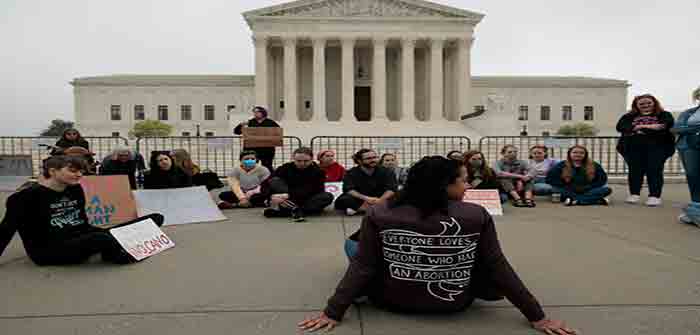
by Glenn Greenwald at Glenn Greenwald
Politico on Monday night published what certainly appears to be a genuine draft decision by Supreme Court Justice Samuel Alito that would overturn the Court’s 1973 decision in Roe v. Wade. Alito’s draft ruling would decide the pending case of Dobbs v. Jackson Women’s Health Organization, which concerns the constitutionality of a 2018 Mississippi law that bans abortions after fifteen weeks of pregnancy except in the case of medical emergency or severe fetal abnormalities. Given existing Supreme Court precedent that abortion can only be restricted after fetal viability, Mississippi’s ban on abortions after the 15th week — at a point when the fetus is not yet deemed viable — is constitutionally dubious. To uphold Mississippi’s law — as six of the nine Justices reportedly wish to do — the Court must either find that the law is consistent with existing abortion precedent, or acknowledge that it conflicts with existing precedent and then overrule that precedent on the ground that it was wrongly decided.
Alito’s draft is written as a majority opinion, suggesting that at least five of the Court’s justices — a majority — voted after oral argument in Dobbs to overrule Roe on the ground that it was “egregiously wrong from the start” and “deeply damaging.” In an extremely rare event for the Court, an unknown person with unknown motives leaked the draft opinion to Politico, which justifiably published it. A subsequent leak to CNN on Monday night claimed that the five justices in favor of overruling Roe were Bush 43 appointee Alito, Bush 41 appointee Clarence Thomas, and three Trump appointees (Neil Gorsuch, Brett Kavanaugh and Amy Coney Barrett), while Chief Justice Roberts, appointed by Bush 43, is prepared to uphold the constitutionality of Mississippi’s abortion law without overruling Roe.
Draft rulings and even justices’ votes sometimes change in the period between the initial vote after oral argument and the issuance of the final decision. Depending on whom you choose to believe, this leak is either the work of a liberal justice or clerk designed to engender political pressure on the justices so that at least one abandons their intention to overrule Roe, or it came from a conservative justice or clerk, designed to make it very difficult for one of the justices in the majority to switch sides. Whatever the leaker’s motives, a decision to overrule this 49-year-old precedent, one of the most controversial in the Court’s history, would be one of the most significant judicial decisions issued in decades. The reaction to this leak — like the reaction to the initial ruling in Roe back in 1973 — was intense and strident, and will likely only escalate once the ruling is formally issued.
Every time there is a controversy regarding a Supreme Court ruling, the same set of radical fallacies emerges regarding the role of the Court, the Constitution and how the American republic is designed to function. Each time the Court invalidates a democratically elected law on the ground that it violates a constitutional guarantee — as happened in Roe — those who favor the invalidated law proclaim that something “undemocratic” has transpired, that it is a form of “judicial tyranny” for “five unelected judges” to overturn the will of the majority. Conversely, when the Court refuses to invalidate a democratically elected law, those who regard that law as pernicious, as an attack on fundamental rights, accuse the Court of failing to protect vulnerable individuals.
This by-now-reflexive discourse about the Supreme Court ignores its core function. Like the U.S. Constitution itself,…
Continue Reading